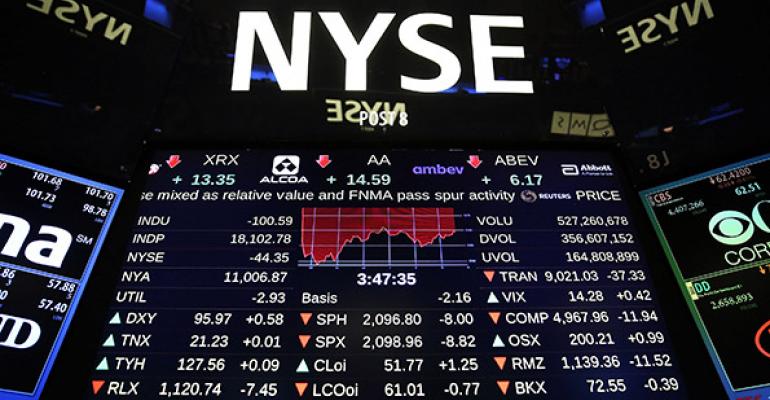By Nicholas Colas
(Bloomberg Prophets) --Equity investing is an optimist’s game. The only time stocks look cheap is when economies are dreadful, making corporate earnings power uncertain. At any other point in the investment cycle, valuations rarely seem affordable. You need a glass-half-full mindset to see the opportunities for earnings growth at those times.
The pessimist still has a role to play, however. Looking at the world with a clear eye is a critical skill to avoid the herd mentality that takes over as stocks rally. With U.S. stocks trading for 18 times earnings and -- before this week -- sleepwalking their way to new highs, we shouldn’t simply ignore the glass-half-empty crowd.
Traditional measures of equity valuation, based on consensus earnings, discount the most optimistic and most pessimistic estimates. Yet there is a lot of information at those extremes. If the most bullish analyst on a given company’s earnings proves correct, chances are excellent that that particular stock is heading higher. And if the pessimist has it right, look out below.
Do that best-/worst-case analysis on the largest names in the S&P 500, and you get a novel take on whether large-capitalization stocks are truly expensive. Or, as the data seem to show, still reasonably priced.
To assess the best-/worst-case scenarios, we pulled the highest and lowest expected future-year earnings for the 20 largest companies in the S&P 500. That abbreviated list holds all the major super-cap technology movers of the year, and also represents almost a third -- 31 percent -- of the index by market cap. These are the stocks that will lead the market higher or lower into the end of the year and into 2018.
Here’s what we found:
- Large-cap stocks are not outlandishly expensive. Even under the worst-case scenario, in which every one of the 20 companies only hits the most pessimistic earnings estimate, this cluster of dominant stocks only trades for 20.3 times earnings. OK, there is one caveat: You have to exclude Amazon, which trades for 299 times worst-case earnings. Including the online retailer, the worst-case multiple pops to 34.2 times. But 20 times is far lower than we thought the number would be before we did the math.
- If everything goes right, large-cap stocks are attractively priced. In the best-case scenario, in which every one of the 20 largest S&P 500 companies hits the highest estimate, the multiple drops to 16.3 times. If you choose to include Amazon, it is 20.7 times.
- In terms of earnings uncertainty, three names stand out. Amazon’s expected earnings in 2018 go all the way from $3.79 a share to $11.00 a share. And, no surprise, energy sector analysts are still iffy on their estimates for ExxonMobil -- $3.20 to $5.32 -- and Chevron -- $3.71 to $6.65.
- Apple has been on a tear of late, so let’s look at that name. Earnings expectations run from $10.11 to $13.29, producing a price-to-earnings range of 13.3 to 17.4 for the shares. In other words, even if Apple only hits the lowest earnings estimate it is still cheaper than the overall market consensus P/E of 18 times.
- Financials have had a tough slog lately as the yield curve flattens, but valuations look attractive. JPMorgan trades for 13.2 times its worst-case scenario earnings, and Bank of America for 13.3 times. Wells Fargo is at 13.6 times, and Citigroup is the cheapest at 13.0 times worst-case numbers.
- Nothing happens in vacuum. If every most-pessimistic analyst proves right, it will mean that the global economy has slowed meaningfully from its current pace. This would certainly draw a response from central bankers. Long-term interest rates would fall as well. Against that backdrop, 20 times earnings -- the worst-case scenario -- wouldn’t look so bad. Lower rates allow for higher earnings multiples.
Conversely, if the bullish analysts prove correct, it may mean the world’s central banks will have to increase rates more quickly than anticipated. That 16 times best-case multiple allows for U.S. 10-year Treasuries to yield in the range of 3 percent to 4 percent and still hold to the old “Rule of 20,” which states that longer-term Treasury yields plus the forward P/E rates on the S&P 500 should equal 20.
All this goes a long way toward explaining why stocks look so bulletproof, grinding higher with little to no volatility. Even under worst-case scenarios, which include a decline in interest rates, large-cap equities are not terribly expensive. Not cheap, but not 25 times forward earnings, either.
This column does not necessarily reflect the opinion of the editorial board or Bloomberg LP and its owners.
Nicholas Colas is the cofounder of DataTrek Research. He is the former chief market strategist at Convergex Group LLC.
To contact the author of this story: Nicholas Colas at [email protected] contact the editor responsible for this story: Robert Burgess at [email protected]
For more columns from Bloomberg View, visit Bloomberg view





